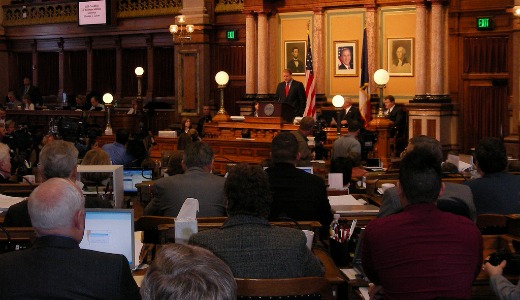
By winning control of a majority of the nation’s state legislatures on Tuesday, Republicans could lock in control of the U.S. House of Representatives for another decade. That’s because next year state legislatures will redraw congressional district lines based on their state’s population figures from the 2010 Census.
It’s a long-term challenge Democrats and progressive Americans in general will have to grapple with.
It’s a process that happens every 10 years, so the districts carved out by state legislators in 2011 will stay in place until 2021, following the next Census. The re-mapping will affect state legislative districts as well as congressional districts.
“Even if you win the presidency and the Senate, for the House these districts will stay with us for the next 10 years,” a Michigan political analyst notes.
The 10-year redistricting cycle was intended to ensure equal voter representation by making sure that congressional districts match population changes. But those weirdly shaped districts you’ll see on the election maps are a testimony to the way state legislators have manipulated this process to try to keep their party in power.
Michigan blogger Peter Bratt calls control of the redistricting process the “real prize” in the 2010 elections.
“In the 2001-2002 redistricting cycle following the 2000 Census,” he writes, “many states, including Texas and Pennsylvania, underwent an aggressive Republican gerrymandering developed to maximize GOP gains in 2002 and 2004. This strategy largely succeeded, allowing the Republicans to further their control of many state delegations.”
With this Tuesday’s results, says Tim Storey of the National Conference of State Legislatures, “The GOP, in dramatic fashion, finds itself now in the best position for both congressional and state legislative line drawing that it has enjoyed in the modern era of redistricting.”
A 1962 Supreme Court decision, Baker v. Carr, established the “one-person, one-vote” rule that requires districts to be redrawn every 10 years.
This week’s elections mean that “Republicans now hold about 3,890, or 53 percent, of the total state legislative seats in America, the most seats in the GOP column since 1928,” said Storey.
In the Midwest, Democrats now hold just 38 percent of state legislative seats, the lowest percentage there since 1956.
Republicans went into this week’s elections controlling 36 state legislative chambers. They picked up control of an additional 18 on Tuesday. “The GOP will now control at least 54 of the 99 state legislative chambers, its highest number since 1952,” Storey said.
They won control of both chambers of the legislature in Alabama and North Carolina for the first time since Reconstruction. They also won control of both legislative houses in Maine, Minnesota, New Hampshire and Wisconsin.
According to Storey’s calculations, Republicans will be in a position to unilaterally draw the lines for 190 congressional districts, while Democrats will be able to unilaterally determine up to 70 districts at most, depending on the outcome of some undecided races.
The rest of the nation’s new congressional district maps will be drawn by state legislatures where Democrats control one house and Republicans the other, or by appointed commissions.
Governors can veto lawmakers’ redistricting maps, but if the governor is a Republican he or she is unlikely to veto Republican lawmakers’ maps.
Republicans won the governorship in at least 11 states formerly held by Democrats. They include the key battleground states of Michigan, Ohio and Pennsylvania. These states have experienced population declines and are expected to lose seats in Congress after the new Census figures are released. When Republicans will be the ones drawing the new district lines, one can expect that traditionally safe Democratic seats will be the ones eliminated.
Democrats won at least three governorships that had been held by Republicans: Vermont, Hawaii and the key state of California.
In California, although Democrats will also control both houses of the legislature, they will not have the power to draw congressional districts, since voters there passed an initiative giving that power to an independent commission.
The Census Bureau will deliver data to state legislatures in early February.
Photo: The Iowa legislature meets, 2007. (IowaPolitics.com // CC 2.0)










